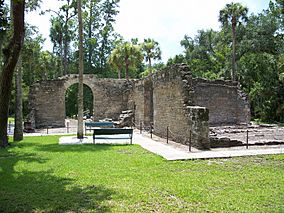New Smyrna Sugar Mill Ruins facts for kids
Quick facts for kids New Smyrna Sugar Mill Ruins State Historic Site |
|
|---|---|
|
IUCN Category V (Protected Landscape/Seascape)
|
|
 |
|
| Location | Volusia County, Florida, United States |
| Nearest city | New Smyrna Beach, Florida |
| Established | August 12, 1970 |
| Governing body | Florida Department of Environmental Protection |
The New Smyrna Sugar Mill Ruins is a cool historic spot in New Smyrna Beach, Florida. You can find it at 600 Old Mission Road, about a mile west of the Intracoastal Waterway. This important place was added to the U.S. National Register of Historic Places on August 12, 1970. This means it's officially recognized as a special place worth protecting because of its history.
Back in 1830, people built a sugarcane mill and a sawmill here. These mills used steam power to do their work. The buildings were made from a unique rock called coquina. This rock is a type of sedimentary rock made from tiny fossilized seashell pieces. They found this rock nearby and used it for construction.
The sugar mill had a crushing house with a tall chimney and big arched openings. Inside, steam-powered machines would crush sugarcane to get its juice. This whole process relied on forced labor from enslaved people and animals. A person called John Dwight Sheldon managed the plantation.
Sadly, on Christmas Day in 1835, Native Americans destroyed the mills and other buildings during the Second Seminole War. Only the strong walls were left standing. The machines inside, made by the West Point Foundry, were mostly okay. Later, soldiers stayed here to watch the Seminole people. This changed the site even more.
History of the Sugar Mill
In 1830, a man named William Kemble agreed to build a steam-powered sugarcane mill and a sawmill. He built them for William DePeyster and Henry Cruger. These two men were merchants from New York who bought and sold goods.
Henry Cruger's wife, Eliza Cruger, and other investors helped pay for the mills. They were built on 600 acres of land near New Smyrna. Cruger bought this land from a minister named Ambrose Hull. Hull had received the land as a gift from the Spanish king during the time Florida was under Spanish rule. This land had also been part of a larger area given to Andrew Turnbull when the British controlled Florida for twenty years.
On December 25, 1835, a group of Seminole Indians attacked the plantation. The manager, John Dwight Sheldon, his family, and the enslaved people living there escaped across the Halifax River to the mainland. That night, the Seminole people set the sugar mill and other buildings on fire.
After the fire, the machines from this sugar mill were moved. They were taken to another place called the Dunlawton Sugar Mill and set up there. For a long time, people thought this site was the ruins of an old Spanish mission called Atocuimi. This mission never actually existed! Even today, some people still believe this false story. But now, the Florida Park Service manages the site as a historic place.

